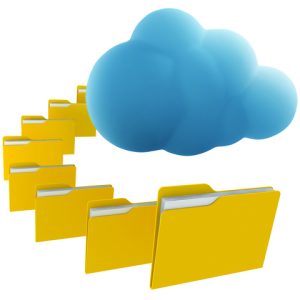The nebulous phrase “the cloud” has entered our daily lives. Many companies such as Google, Microsoft, Apple, and Amazon are adding cloud services as quickly as possible. New and existing companies are rushing to create new cloud applications. Every recent commercial and software update highlights some new connection to the cloud. To understand the cloud, we must first understand the limitations of the traditional local computer. Then, we can explore the advantages of the cloud by examining some popular cloud based services.
The Limitations of the Local Computer
The local computer is the traditional PC or mac. All of the user’s files, data, and applications are located on that one computer. The computer has a finite amount of CPU and memory for processing and hard drive space for storage. If something were to damage that system, all the data is at risk of being lost. A cloud process is the opposite of a local one. The cloud is a network of computers accessed through the internet that share a large distributive collective of CPU, memory, and storage resources. Files that need to be transported are emailed, placed on USB drives, or burned to a disc. A specific application can only be used on that computer and that computer only.
Here is a common local computer scenario. A PC user creates a word processing document, stores it on his computer, and then emails it to his partner. The partner in turn edits the file with his version of the word processor, saves it, and emails it back to the original user. The process repeats back and forth until both parties are happy with the final project.
Limited by local computers both users are forced to work from their own specific systems and applications. The versions saved on the hard drive may be different than the ones received through email. Each saved revision must be managed and requires additional storage on both computers. The versions of the word processing application may be different and may not be compatible.
What is the cloud?
A cloud process is the opposite of a local one. The cloud is a network of computers accessed through the internet that share a large distributive collective of CPU, memory, and storage resources. Data and applications in the cloud can be accessed by anyone with an internet connection. Data and files can easily be shared and manipulated by multiple parties simultaneously. Even if a user’s local system crashes or is destroyed, the user’s information in the cloud is retained.
The previous word processing example looks very different in the cloud. Each user can edit the file on the cloud server through any computer with a browser or associated application. Managing versions and storage of the file is handled automatically. Application incompatibilities are not an issue since both users are using the same application online.
Popular Cloud Services and Benefits
Everybody knows that Yahoo, Microsoft, and Google all offer web mail (or browser-based) services. However, it is important to note that email was one of the very first services to embrace the cloud. Local email on a computer is difficult to access from other computers. Local emails also risk being lost if something happens to the user’s computer system. Living in the cloud, web mail overcomes these limitations. The application runs there and the data is stored there. Any computer or mobile device with an internet browser can access email in the cloud. Now web mail is the norm, and society’s comfort with it has allowed the cloud to rapidly gain in popularity.
Traditionally, a young internet company would buy a server to run its application or website. As the popularity grew, the local server would be updated or upgraded. Amazon has now expanded this to a cloud based system. Where a traditional server might need downtime to physically add memory or storage, the Amazon Web Services (and other such services) allow for a company’s web application to expand seamlessly within the cloud-based system as needed.
Another cloud-based explosion deals with media. Audio and video files are large and bulky. They can quickly fill up a local hard drive. A user trying to share the media between his or her multiple playable devices will quickly become frustrated. Having the media library in the cloud solves a majority of these issues. Nobody actually sends video files anymore. Uploading them to YouTube allows for easy storage and sharing. Likewise, both Google and Apple are working on cloud based music storage. Once a music library is uploaded to the cloud, it is much easier to share the songs to multiple devices.
A user trying to share the media between his or her multiple playable devices will quickly become frustrated. Having the media library in the cloud solves a majority of these issues. Nobody actually sends video files anymore. Uploading them to YouTube allows for easy storage and sharing. Likewise, both Google and Apple are working on cloud based music storage. Once a music library is uploaded to the cloud, it is much easier to share the songs to multiple devices.
Cloudy Conclusions
The benefits and convenience of these services have led to the cloud’s popularity. Overall, cloud based systems are leading the latest revolution in technology and users are overwhelmingly embracing it.
Although its advantages are vast, the cloud also comes with many unique concerns and limitations. I’ll explore that in my next article.





